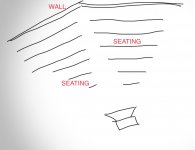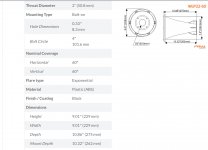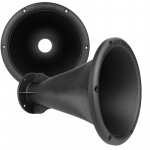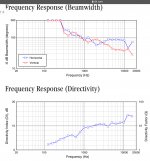What are the drawbacks of the conical horns like Selenium HL14-50N? Obviously the coverage pattern is round instead of squarish. Is there some reason why they aren’t used in commercial designs?
I am considering a build with similar 60x60 PRV Audio WGP22-50 because the room is hexagonal, and each cabinet presents to a wedge of seating.
I am considering a build with similar 60x60 PRV Audio WGP22-50 because the room is hexagonal, and each cabinet presents to a wedge of seating.
Attachments
For the low frequency cutoff point of the horn they have to be of large size. This means they cannot be as acoustically close at the crossover frequency. This causes uneven response through the room at the crossover frequency. There is also a 'waist banding' phenomenon where the dispersion narrows in the midrange for a pure conical horn but I am not sure why this happens.
Actually looking at your horn its not conical as it doesn't have straight sides, its described as exponential and doesn't seem to have constant directivity characteristics. So its proboble that its other description as an exponential horn is correct. There have narrowing dispersion with increasing frequency and are not well suited to covering large audiences.
*further examination shows a polar response looking like a laser beam at 16kHz and a 2" throat, so I would so its a midrange exponential horn usable up to ~3 kHz.
*further examination shows a polar response looking like a laser beam at 16kHz and a 2" throat, so I would so its a midrange exponential horn usable up to ~3 kHz.
Last edited:
I'm no expert, but I think Danley's horns are all conical (albeit rectangular or square mouth). Below a certain frequency it does not matter if square or round mouth (?)
Actually looking at your horn its not conical as it doesn't have straight sides, its described as exponential and doesn't seem to have constant directivity characteristics. So its proboble that its other description as an exponential horn is correct. There have narrowing dispersion with increasing frequency and are not well suited to covering large audiences.
*further examination shows a polar response looking like a laser beam at 16kHz and a 2" throat, so I would so its a midrange exponential horn usable up to ~3 kHz.
By my research, most horns are laser beams at 16kHz, or at least the polar graphs and off-axis response suggest.
I ordered some, so we’ll find out.
Last edited:
My original description of ‘conical’ was a lazy reference to the visual appearance - conical shape - versus rectangular mouth of many waveguides. I should not have used that term because these ARE exponential.
I bought these:
WGP22-50 - PRV Audio
I bought these:
WGP22-50 - PRV Audio
Attachments
By my research, most horns are laser beams at 16kHz, or at least the polar graphs and off-axis response suggest.
I ordered some, so we’ll find out.
not so you just need the right horns:
https://www.jblpro.com/ProductAttachments/3730 Spec Sheet.pdf
not so you just need the right horns:
https://www.jblpro.com/ProductAttachments/3730 Spec Sheet.pdf
Certainly there are exceptions. I wonder why they don’t use those horns on speakers marketed for PA? The SRX series for example?
https://www.jbl.com/on/demandware.static/-/Sites-masterCatalog_Harman/default/dw5e2e0139/pdfs/JBL_SRX815_SpecSheet_8%2013%2015.pdf
Attachments
Quite a lot of the JBL stuff uses >1" exit compression drivers that reduces the dispersion in the top octave unless you have a diffraction slot (considered to not sound nice). The advantage of the larger exit allows a greater SPL for a given distortion threshold. For products designed for high level playback spectral masking means that you will not be able to hear the very high frequency content anyway so the lack of dispersion may not be noticeable. The same kind of trade off is done in a hi-fi speaker where a 1" dome is used instead of a 0.75" dome.
Quite a lot of the JBL stuff uses >1" exit compression drivers that reduces the dispersion in the top octave unless you have a diffraction slot (considered to not sound nice). The advantage of the larger exit allows a greater SPL for a given distortion threshold. For products designed for high level playback spectral masking means that you will not be able to hear the very high frequency content anyway so the lack of dispersion may not be noticeable. The same kind of trade off is done in a hi-fi speaker where a 1" dome is used instead of a 0.75" dome.
I read through your thread on waveguides. Good stuff in there, thanks for contributing. If I can get decent 10kHz coverage, that will be a wild success for improving sound in this room. I am considering placing a small ~1” piece of absorption (like rigid fiberglass I have available) on the grille, dead center of the horn if HF beaming is problematic. And then EQ highs around that.
Distance is 20’ in front to 55’ in the back. It will have full DSP available, active, bi-amped.
Last edited:
- Home
- Live Sound
- PA Systems
- Conical Compression Horn Waveguides




